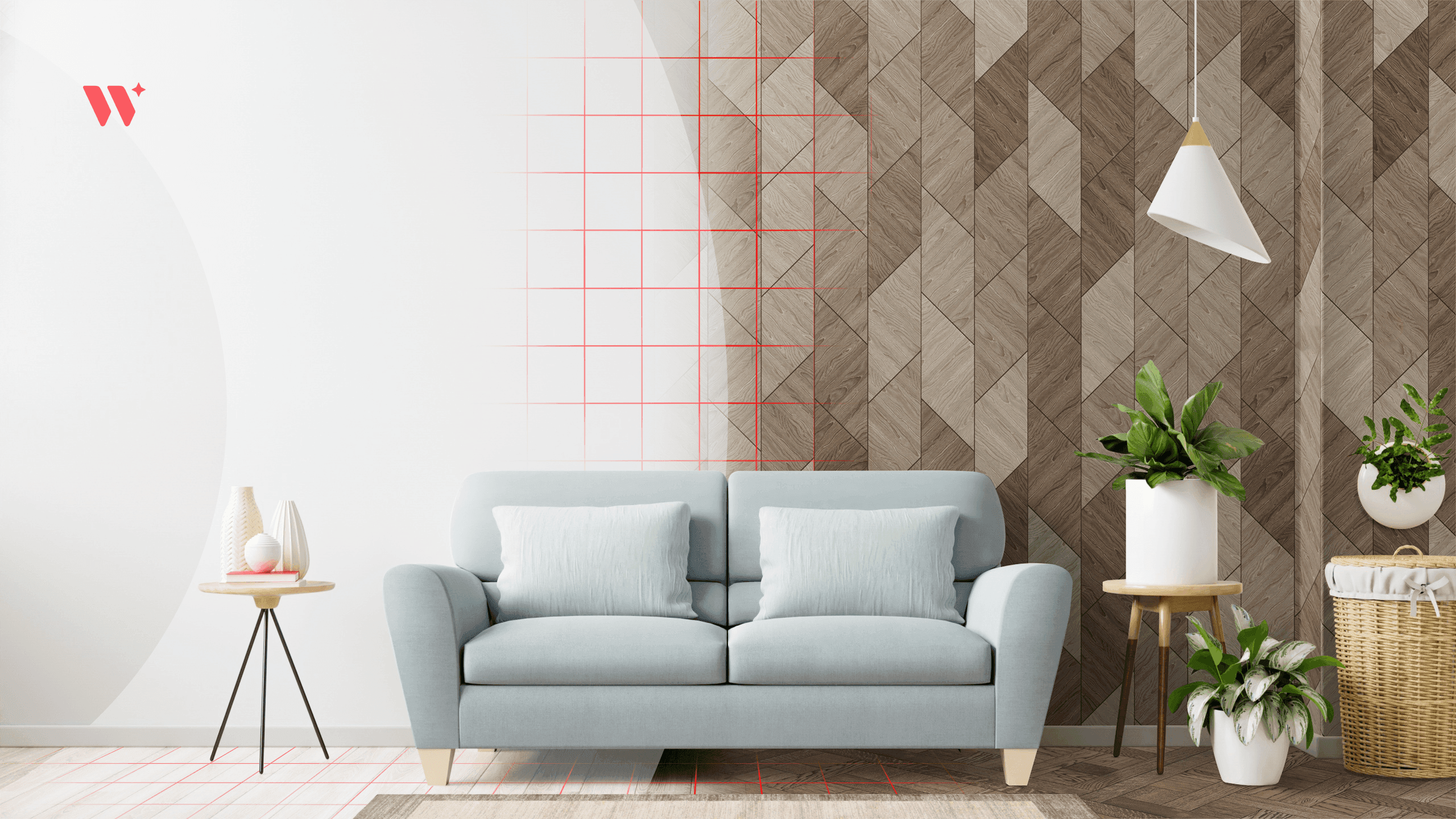How to Create a Showroom-Level Digital Experience: 12 Ways to Improve E-commerce for Finishing Materials

Buying finishing materials online is an emotional and technical decision – and not a simple one. Customers aren’t just browsing for “something that looks nice.” They’re trying to envision how a tile, wall covering, or floor will transform their space, complement natural light, match other materials, and hold up over time.
But here’s the challenge: the products are often tactile, textured, or reflective – characteristics that are hard to translate through a screen. The stakes are high too: finishing materials are rarely impulse buys. They're part of a larger renovation or design project. Customers need to feel confident before clicking “Add to Cart.”
To make that happen, the truly excellent customer experience must be more than functional – it needs to replicate the benefits of an in-store visit and go even further. Below are 12 tailored strategies to improve your e-commerce experience for finishing materials and turn browsers into confident, loyal buyers.

Provide detailed, accurate product information
For finishing materials, information isn’t just helpful – it’s essential. A vague or incomplete product description can easily lead to returns, disappointed customers, or lost trust.
Each product page should act like a well-trained salesperson. Include:
- Full product specifications (dimensions, weight, texture, sheen level, water resistance, material composition, etc.)
- Installation instructions and tools required
- Compatible products or systems (e.g. matching grouts, adhesives)
- Usage areas (wet rooms, outdoor, high-traffic areas, etc.)
- Care and maintenance guidelines
- Certifications (eco-labels, fire ratings, etc.)
A buyer should never leave your product page with open questions. When in doubt, overshare.
Use high-quality visuals and interactive customer experience solutions
Finishing materials are a visual business. And when shoppers can’t see them in person, your media assets must fill that gap.
Standard pack shots won’t cut it. Here’s what works:
- Multiple high-resolution images (close-ups, room scenes, details under different lighting)
- Zoom functionality to inspect texture and finish
- 360-degree rotations, especially for 3D materials
- Short videos to demonstrate sheen, size, or texture in motion
But the most powerful upgrade? Interactive room visualization.

Highlight: Wizart Visualizer
Wizart Visualizer lets customers see your products – tiles, rugs, wall panels, murals, and more – directly in their own rooms using AI-powered visualization.
How it works:
1. Your store integrates the visualizer – via a plugin, a single line of code, or Wizart’s API.
2. Customers upload a photo of their room.
3. They select a product from your catalog.
4. The visualizer instantly renders a realistic preview, automatically adjusting scale and perspective.
This transforms the experience from abstract browsing to confident visual planning – and drives results:
- 5× increase in conversions
- 4× faster decision-making
- 40% reduction in returns
- 27% increase in engagement
Customers move from “Will this work?” to “This is exactly what I want.”
Implement personalized customer experience
People don’t shop for finishing materials the same way. A first-time DIY renovator is very different from a professional interior designer sourcing for a commercial project.
Use data to deliver a tailored experience:
- Show recommendations based on browsing behavior or purchase history
- Display complementary products (e.g. a baseboard with a floor, a sealant with tiles)
- Segment email flows by user intent (project size, type of property, location)
- Offer design style filters – rustic, modern, Scandinavian, etc.
The result? Customers feel understood. And understood customers stick around longer and convert more often.
Optimize for mobile devices
Many users start their journey on mobile – researching products while commuting, during a site visit, or chatting with a contractor. A poor mobile experience means you might lose them before they ever reach the buying phase.
Make sure your mobile e-commerce experience:
- Loads fast (especially image-heavy product pages)
- Supports all product visual features
- Has tappable filters and dropdowns designed for thumbs
- Offers full access to the visualizer tool (Wizart works perfectly on mobile)
- Enables smooth, intuitive cart and checkout flows
Mobile should support, not limit, a retail customer experience.
Bonus tip: make it easy to “save” visualizations or product choices for later – many customers move between mobile and desktop before purchasing.
Create a consistent omnichannel experience
Your customer might first encounter your product on Instagram, visualize it on your website, and place an order after an email follow-up.
That journey only works if every channel feels connected.
To build true omnichannel consistency:
- Synchronize branding, product names, and visuals across platforms
- Ensure inventory and pricing match between website, social, and marketplaces
- Allow users to pick up where they left off (e.g. saved visualizations or carts)
- Unify communication across support, sales, and marketing
The goal is to make the customer feel like your brand is one seamless experience – not a collection of disconnected touchpoints.
Implement easy-to-use filters and search
A strong filtering system is non-negotiable when customers face hundreds of similar-looking tiles or dozens of paint types.
Best practices include:
- Filters by texture, finish, color, pattern, size, price, and material
- Visual filters (e.g. swatches or icons for colors and textures)
- Smart search with autocorrect and suggestions
- Tag-based navigation for common projects (e.g. “small bathroom,” “high-traffic floors”)
In Wizart’s Visualizer, these principles are brought to life through intuitive filters and smart image search – helping users quickly find matching products and making the browsing experience as seamless as possible.
Combined with a clean UI, this enhances usability and helps improve customer experience dramatically.
Showcase customer reviews and user-generated content
You can show a product 100 ways, but nothing builds trust like seeing it in someone else’s home.
Encourage satisfied customers to:
- Leave detailed reviews with images
- Share before-and-after project shots
- Tag your products on Instagram or Pinterest
- Submit design stories that show how they used your materials
Even better – allow product visualizations (e.g., from Wizart) to be saved and shared. This user-generated content helps future buyers get inspired and builds a sense of community around your products.
Simplify the checkout process
You’ve helped a customer find, explore, and fall in love with a product. Now don’t lose them at the finish line.
Remove all friction:
- Offer guest checkout
- Use address autofill and Google Pay/Apple Pay options
- Display shipping costs and estimated delivery time upfront
- Allow saving carts or product bundles for later
- Offer flexible payment options (especially for bulk or B2B orders)
If your visualizer is in play, make sure the visualized product selection flows directly into the cart – no need to reselect anything.
Offer live chat and AI support
Finishing materials invite questions: Can I use this on a ceiling? What prep does the wall need? How much waste should I calculate for this tile?
Artificial Intelligence and customer experience go hand in hand here, especially when AI is paired with real support.
That’s where real-time support shines:
- Implement a chatbot to handle basic product and order queries
- Route technical questions to knowledgeable live agents
- Add visual chat features (e.g. customer can upload room photos for support)
- Integrate chat into product and visualization pages for contextual help
The faster your support, the less likely a hesitant buyer turns into a lost one.
Leverage data analytics and feedback
The best e-commerce stores don’t just guess what customers want – they study it continuously.
Track and analyze:
- Which products are visualized most often (Wizart includes analytics)
- Which filters and searches lead to purchases
- Drop-off points in the funnel
- Return reasons and product-related complaints
Pair this with customer reviews and chat logs to refine the customer experience solutions. A data-driven store is a customer-centric store.
Integrate educational content for e-commerce customer experience insights
Education builds confidence. It also positions your brand as an expert, not just a seller.
Types of content that work well:
- Step-by-step installation guides
- How-to videos
- Inspiration galleries organized by room type
- Style comparison charts (e.g. matte vs. gloss tiles)
- Blog posts about trends, materials, and maintenance
- Case studies and customer interviews
Don’t just tell people to buy. Help them understand why and how to make the best choice – and use tools like Wizart to visualize those choices in action.
Use retargeting and personalized follow-ups
Not every customer is ready to buy right away. That’s fine – but you want to stay top of mind.
Strategies to re-engage:
- Retarget ads with personalized product images
- Email follow-ups with visualizations they created
- Price drop or back-in-stock alerts for favorited products
- Inspiration emails with similar room designs or bundles
If someone visualized a product in their own space, use that insight to reconnect – remind them of what they loved.
Final thoughts
Selling finishing materials online doesn’t mean settling for a second-rate customer experience. With the right tools – from AI and customer experience integrations to data-backed solutions – your digital journey can feel tactile, personal, and reliable.
By investing in solutions like Wizart Visualizer, optimizing every touchpoint, and continuously learning from your customers, you give buyers the confidence they need to make decisions in an otherwise high-stakes category.
Remember: you’re not just selling tiles or paint. You’re helping people realize their vision for space. That requires trust, imagination, and a thoughtfully crafted personalized customer experience that rivals (and even beats) the in-store one.
Deliver the best customer experience, and you’ll win not just the sale – but long-term loyalty.
